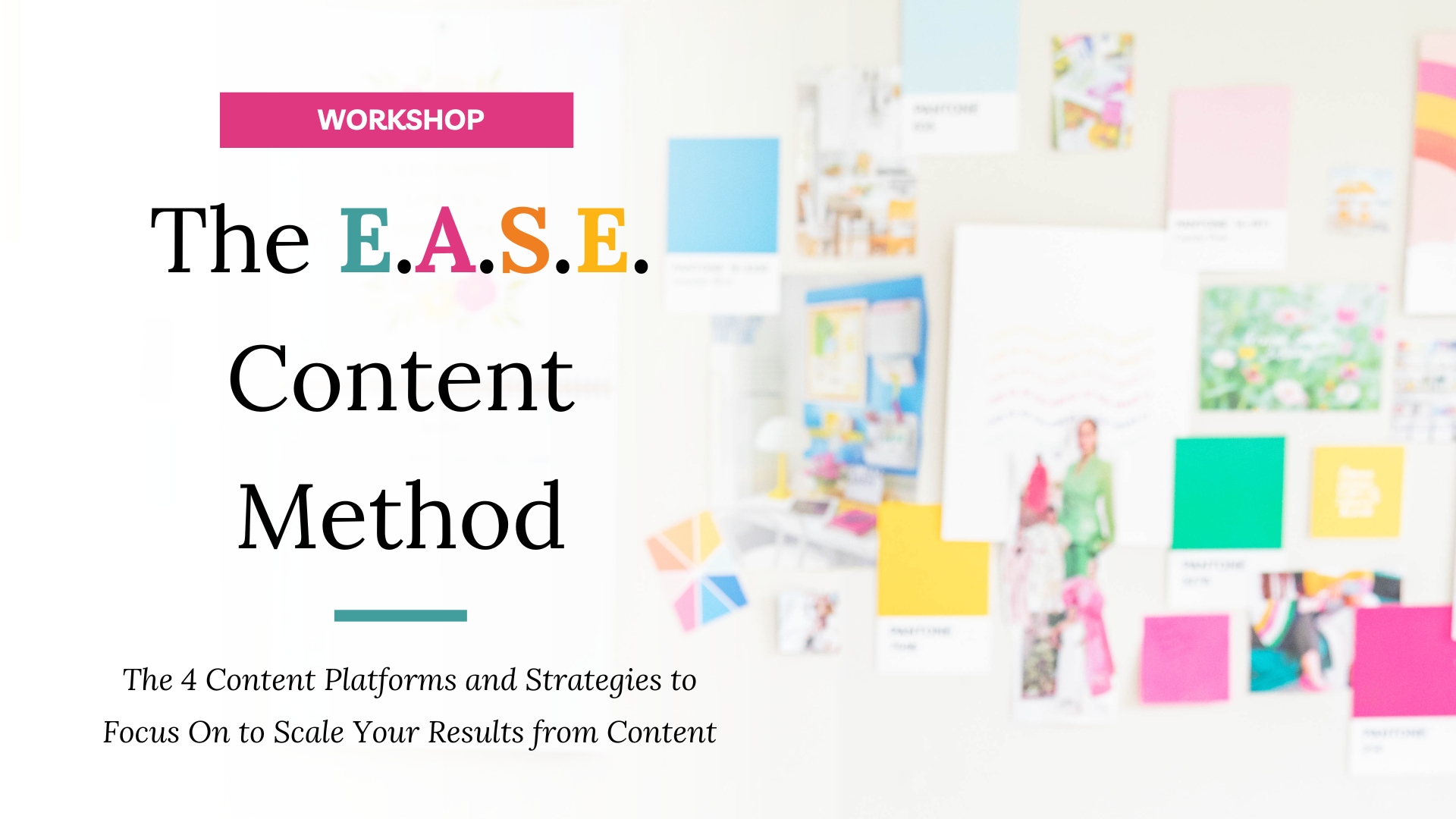Not reaching enough new people to support your business goals? Learn how to get in front for 500 new people every month (or more) in this week's episode ⬇️
In this episode, we’re talking the power trio (Paid ads, collaborations, social media) and learning how to stack traffic sources so you can hit your numbers.
Here’s a few other things we’re discussing:
- Picking and sticking with a game plan: The importance of choosing and committing to a content strategy for a set period, typically 90 days, before evaluating its efficacy
- Layering and diversifying platforms: Start with what works, then branch out. Don't put all your eggs in one basket, and definitely check out the PESO model
- Regular evaluation and optimization: Always be nosy about how you're doing. Tweak stuff based on what's working, and seriously, know your numbers (because math doesn't lie!)
Ready to Learn the Perfect Content Strategy for Simplifying Your Content Strategy While Scaling Results?
Get instant access to my E.A.S.E. Content Strategy Workshop where you'll learn the 4 content platforms and strategies to focus on to scale your results and sales from content. Plus you'll get my exclusive EASE Content Planning Spreadsheet for FREE ↓

FULL TRANSCRIPT:
Welcome back to the Content Coffee Break podcast. I'm thrilled to have you here as we discuss how to get in front of 500+ new people every month using content. For the first time, I'm recording this a bit late because I wanted to record after our recent workshop, which I hosted last week. We had 300 participants between the live session and the replay, and it was incredible. I'm setting my intention for 2024 to allocate more time for live teaching and workshops. I deeply enjoy sharing tools that I typically reserve for one-on-one clients with a broader range of business owners from various niches and models. It's amazing to see how this can be adapted to diverse circumstances and applications.
We've also begun enrollment for “Your Content, Your Empire Live,” which is centered on the ease content framework. This is my seventh time running this program. It's among my top three signature programs and the one I usually suggest taking second, after the “Profitable Funnel Sprint.” The latter helps provide content with a clear purpose, setting up an automated sales and welcome system. Then, when you're ready for traffic, you can transition to the minimalist content system. “Your Content, Your Empire” was my inaugural program, and I've been offering it once a year. I eagerly anticipate our newest group of participants.
Our main focus is helping business owners get in front of at least 500 new individuals monthly using content. Once their sales funnels are established, the next challenge becomes traffic. How can you attract more people to this funnel consistently to achieve your monthly revenue and sales goals? While the 500 figure may vary depending on your business model, it's often the subsequent challenge entrepreneurs face.
Before we delve deeper, I want to update you on a contest I hosted to commemorate this podcast's launch. While I couldn't announce it in the prior episode, I'm thrilled to reveal that Bec McFarland from Pop Your Business is our winner!
Now, let's explore how to reach 500+ new people monthly with content. This episode is essentially the culmination of our previous discussions related to the ease content framework. If you're just joining us, I recommend checking out our earlier episodes for a comprehensive understanding. In essence, the ease content strategy framework simplifies your content. Rather than trying to be everywhere, we emphasize a balanced strategy. This includes having content for education, attracting new audiences, sales strategy, and an engagement platform.
In our first episode, we discussed the importance of selective presence. The second episode provided insights on creating a balanced strategy. We delved into mapping out your ease content strategy in the last episode.
After the workshop, many wanted to know how to align their content with their goals. They sought a tangible, measurable strategy. It's crucial for businesses to imbue their content with purpose, typically through an automated sales system. After establishing that system, the next step is reaching the right audience.
Here's how to determine your audience goal. First, align it with your business model. If you sell numerous digital products to reach a sales goal, you'll need to attract more people than if you were selling a high-ticket coaching or service package. So, set a goal based on your product sales target. Using average conversion rates, determine the number of leads required to achieve these sales. From there, consider how much traffic your offers need to get those leads. It's vital to base these goals on real data. If you're more growth-focused, assess how many people currently view your offers, how many leads you gain, and the resulting sales. This helps set achievable growth targets.
Many, after creating this projection model, wonder how they'll reach their target audience numbers. That's precisely what we'll address today.
I'm going to outline the three most common tactics and strategies to reach your school target, whatever that number may be. It's crucial to determine that number first. Is it 500? More or less? Once you know, I'll delve into the three prevalent strategies to hit that target. More importantly, I'll connect it to the systems we always discuss, especially the system we cover in “Your Content, Your Empire.” This system is crucial to easily achieve your goals without becoming overwhelmed. So, let's discuss the three main methods to increase traffic.
Paid Ads: The most straightforward answer is ads, such as Facebook or Instagram, which rank at the top for me. Depending on your niche and if you're focusing on search intent with optimized keywords, Google ads can be another excellent choice. One of my favorites, especially for evergreen content, is promoted pins on Pinterest. When using paid ads, it's essential to break down your investment into tangible returns, like traffic, leads, and sales. You need to know your cost per lead, cost per click, and your earnings per lead. The difference between your cost per lead and earnings per lead is your profit. The system becomes scalable once you optimize these numbers, especially with vast audiences available. However, one should not rush into paid ads without a proper sales system in place. Otherwise, you might waste money without seeing a return on investment. I recommend using paid ads once you have reliable metrics, especially for newer funnels.
Collaborations (Summits & Bundles): Collaborations, specifically summits and bundles, are becoming increasingly popular. They might involve teaming up with others for presentations or interviews over a set period. Participants benefit from a larger collective audience, but it's essential to nurture these new leads properly. Often, subscribers from bundles or summits aren't immediately invested in your content. They might be on multiple lists, so it's crucial to provide a strong welcome sequence and build a relationship with them. If you choose this strategy, focus on nurturing these leads effectively.
Social Media Sprints: While social media is a known platform, I'd like to highlight the “social media sprint.” This strategy is ideal for those with new sales systems or offers. It involves picking a high-visibility platform like TikTok, Instagram reels, or Pinterest and intensively growing it for 90 days. You need to be consistent, post daily, and perhaps even more than you think is necessary. Ensure that your platform profiles are optimized. I recommend this as a starting point for a new funnel, as it offers an initial insight into numbers. After this, you can potentially move on to paid ads with a clearer projection model.
These strategies offer various pathways to boost traffic and achieve your goals. However, it's vital to choose what aligns with your current situation and objectives.
Regardless of which option you choose, whether one of these three most recent ones or focusing on something else, what you do afterward matters. Once you complete your chosen focus period, be it 90 days as I recommend or perhaps 30 days if you're certain the platform or strategy isn't for you, what then?
The strategy I recommend involves three choices: delete, delegate, or systemize. Once you've decided on a strategy, you scale it, then delegate, automate, or reduce your input. For instance, commit to a single platform or strategy for 90 days, measuring its effectiveness along the way. The initial 90 days are crucial for systemization. Create daily, weekly, and monthly systems for your chosen platform or strategy, as well as one-time setup activities. Once the 90 days are over, review your progress. While I suggest checking in at the 30-day mark, a comprehensive review at the end is vital.
At this point, ask yourself if this is a strategy you wish to continue. Sometimes, the goal might be to delegate the task, or to optimize it to require less of your time. Remember, it's often more demanding to initiate a new strategy than to maintain an existing one.
Conversely, you may find the strategy unfruitful and choose to move on. In such cases, it might be best to delete it altogether. If you do decide to continue, it's about leveraging principles like layering strategies. Even though I advise focusing on one method of attraction or engagement initially, with time, you might run multiple platforms simultaneously. I've discussed the balance between amplification and focus channels in previous episodes. Amplification is about maximizing distribution with minimal effort, possibly by repurposing content for different platforms.
The principle of effective frequency comes into play here. Historically, a movie-goer needed to see a film poster 21 times before wanting to watch the movie. In today's world of relentless advertising and notifications, the required touchpoints might be even higher. Thus, engaging with your audience across different platforms is beneficial.
An interesting strategy to note is the PESO model from Gini Dietrich of the PR firm Spin Sucks. PESO stands for Paid, Earned, Shared, and Owned. It's vital to diversify and not solely rely on one type. For example, “Paid” encompasses advertising and affiliate promotions, “Earned” refers to collaborations, PR, and guest appearances, “Shared” pertains to social media, and “Owned” includes your website and email list. When building a strategy, consider incorporating elements from each category.
To sum up, always be aware of your numbers. Know your traffic requirements, current traffic sources, and decide on your focus for the next 90 days. The aim is to achieve clarity and meet your targets. If you're interested in delving deeper, consider joining us in “Your Content, Your Empire.” Early bird enrollment ends on September 14th, but you can still join until the 17th. For more details, visit yourcontentempire.com/YCYE. If you have any questions, don't hesitate to reach out. Thank you for tuning in, and I'll see you next time.
Ready to Implement?
Get instant access to my E.A.S.E. Content Strategy Workshop plus get my exclusive EASE Content Planning Spreadsheet for FREE ↓








